Climate Ready Scotland: climate change adaptation programme 2019-2024
A five year programme to prepare Scotland for the challenges we will face as our climate continues to change.
Outcome 4: Our society’s supporting systems are resilient to climate change
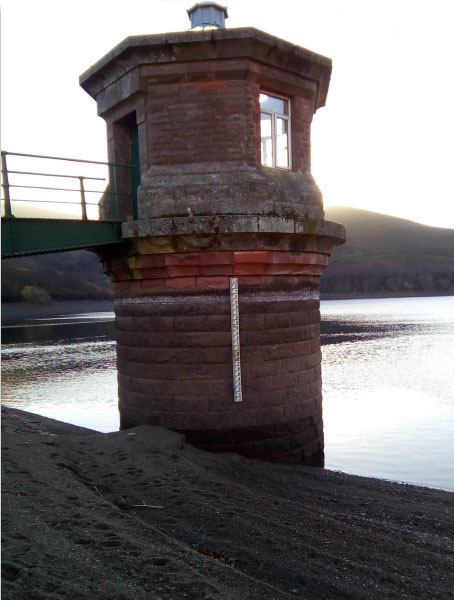
Image 4.1. Hopes Reservoir
Introduction
Scotland’s supporting systems, or infrastructure, comprise the facilities, systems, sites and networks necessary for the functioning of the country and to enable, sustain or enhance societal living conditions. Communities across Scotland depend on our infrastructure, including housing and cultural facilities, access to transport, communication, health services and supplies of energy and water.
Infrastructure in Scotland both depends on, and is impacted by, the environment. Flooding and landslides can make roads and rail impassable, high winds and heavy rain can cause damage to electricity networks, and erosion can damage coastal infrastructure. Maintaining delivery of services is critical, and is particularly important for rural and island communities in Scotland, where these services can provide lifelines.
In Scotland, some parts of infrastructure are devolved to the Scottish Government, while some remain reserved at the UK level. Where sectors are devolved, the related decision making power rests with the Scottish Government.
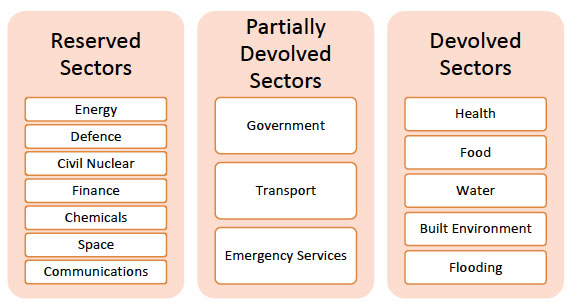
Image 4.2. Reserved, partially devolved and devolved infrastructure sectors in Scotland
Critical infrastructure is essential to the functioning of the society and economy in Scotland. This may be direct, in the form of a major trunk road, or indirect, such as the energy supply that underpins a data centre. The loss or disruption of these systems could lead to severe social or economic consequences. As climate change increases the likelihood of extreme weather events (including flooding, storms and heat waves), it is important that our infrastructure systems are resilient to the future climate.
Infrastructure sectors do not operate in isolation and having interconnected sectors increases the risk of cascading infrastructure failures, for example, energy supply underpins water and wastewater treatment systems, IT infrastructure, and signalling for roads and rail. Infrastructure assets, such as bridges, may support cables and pipes carrying energy and water.
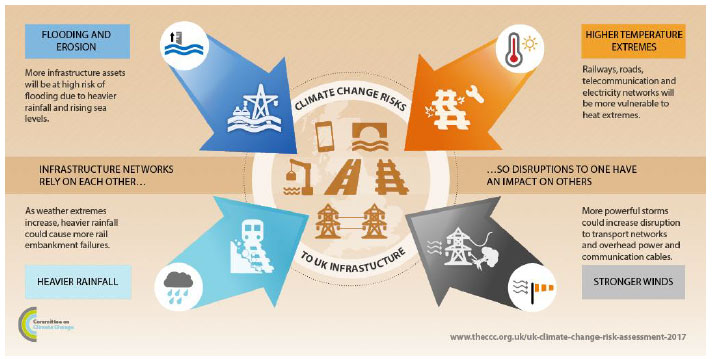
Image 4.3. Risk of cascading infrastructure failures (© The CCC)
Where We Are Now
Investment in infrastructure is vital to supporting and delivering a prosperous and successful Scotland. At a fundamental level, infrastructure requires construction and maintenance of the physical buildings and networks that facilitate service delivery across Scotland. Infrastructure is also a critical element for achieving sustainable economic growth and boosting international competitiveness.
Our National Infrastructure Mission, set in 2018, commits us to a steady increase in the level of infrastructure investment from now until the end of the next Parliament. To support the delivery of this Mission, we have established an independent Infrastructure Commission for Scotland which will advise the Scottish Government on national infrastructure priorities, including how to prioritise investment to deliver low carbon objectives. In 2020, we will produce the next Infrastructure Investment Plan which will set out a comprehensive plan across the sectors for the next 5 years.
Infrastructure plays a critical role in how a place functions. Infrastructure can help us to build places where people have choices about how they move around, access facilities and live sustainable healthy lives. Scotland’s building standards underpin the quality of our built environment, ensuring buildings are safe, efficient and sustainable. The Scottish Government also supports place-based approaches to adaptation, with Climate Ready Clyde, Edinburgh Adapts, Aberdeen Adapts and Levenmouth Adapts being examples of these. These approaches are cross-sector initiatives that aim to create a shared vision of adaptation for a region. Adapting and maintaining climate resilient infrastructure is an integral part of this vision.
Infrastructure projects can range in scale and provide multiple co-benefits to different areas. Blue-green infrastructure, for example, can act to enhance drainage and reduce flooding, whilst also increasing air quality, biodiversity, human health and emotional wellbeing through access to greenspace. Improvements in the resilience of Scotland’s infrastructure will have positive impacts on multiple areas, and contribute to each of the outcomes in the Adaptation Programme.
Significant progress has been made to improve the resilience of Scottish infrastructure over the last few years, with more action ongoing. One of the most visible recent projects is the opening of the Queensferry Crossing, the biggest infrastructure project in Scotland in a generation. Since opening, its wind shielding has made it less susceptible to closure during high winds than the Forth Road Bridge. Other design features have increased the bridge’s resilience to extreme weather and the changing climate.
The Perceptions of Trunk Road Networks in Scotland survey showed that in 2017, 67% of respondents had at least one journey over the previous year disrupted by severe weather. Data on this issue continue to be collected through passenger and customer care focussed surveys. In 2005, Transport Scotland published the Scottish Road Network Climate Change Study, it was refreshed in 2008 and 2011. Following the publication of new UK Climate Projections in 2018 (UKCP18), consideration is being given to a further refresh.
The second National Flood Risk Assessment, published in 2018, provides increased detail regarding flood risk. In addition to mapping risk to communities and heritage sites from flooding, it also maps potential areas of vulnerability for infrastructure assets. Better understanding of flood risk vulnerable areas enables prioritisation of actions.
In 2011, Secure and Resilient was published, providing a strategic framework for critical national infrastructure in Scotland. This strategy remains active, establishing governance arrangements and providing strategic direction for critical national infrastructure resilience stakeholders. Climate change is a key factor that critical national infrastructure stakeholders must consider in implementing the strategy.
The following diagram outlines the structure of the Supporting Systems chapter. It is divided into three Sub-Outcome and sets out the policies that contribute towards this outcome. The Sub-Outcomes consider devolved and reserved infrastructure and the interdependencies between these infrastructure systems.
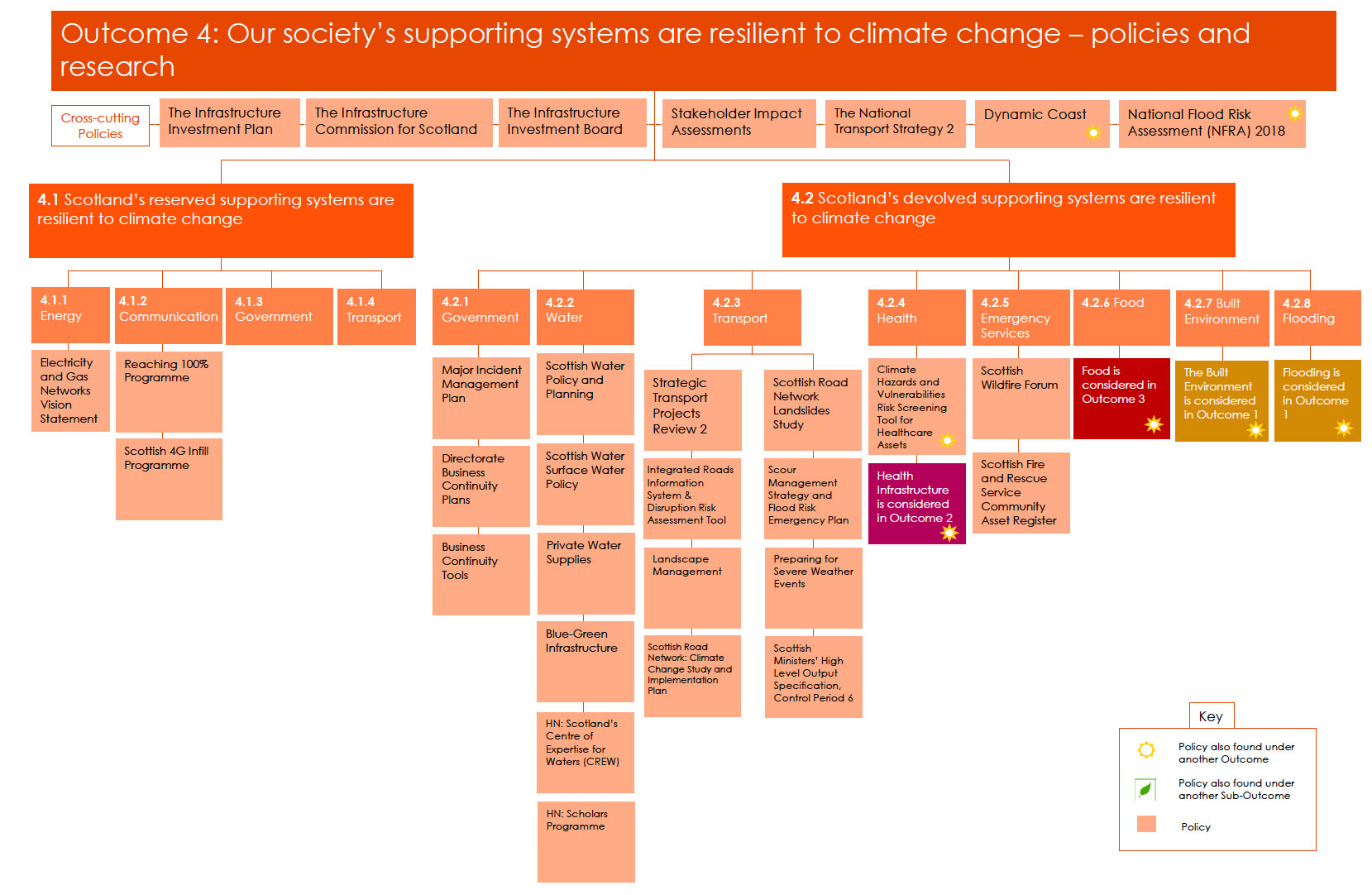
Cross-Cutting Policies
The following policies support the understanding of the likely impacts of climate change on our infrastructure and supporting systems.
| The Infrastructure Investment Plan |
|
|---|---|
| The 2015 Infrastructure Investment Plan set strategic priorities for infrastructure investment across Scotland. The plan is framed by four themes: tackling inequalities, supporting a low carbon economy, high quality public services, and supporting employment opportunity across Scotland. The next Infrastructure Investment Plan (IIP) will build on the Infrastructure Commission’s recommendations and take account of our National Infrastructure Mission. The Plan will be published by June 2020 and cover the next Parliamentary term. The IIP will reflect this commitment to delivering infrastructure projects which support our transition to a net-zero emissions economy by 2045. In developing the IIP we will also carefully consider the UK Risk Assessment, UK Climate Impact Projections and Scottish policy documents in informing how our infrastructure should adapt to changing climate. |
|
| Timeline: Next Infrastructure Investment Plan due for publication in 2020 |
Owners: Scottish Government |
| The Infrastructure Commission for Scotland |
|
|---|---|
| The Infrastructure Commission was set up to provide independent, informed advice on the vision, ambition and priorities for infrastructure in Scotland. The Commission will support delivery of our National Infrastructure Mission and development of the next Infrastructure Investment Plan until 2023. A central part of the Commission’s remit is to consider managing the transition to a more resource efficient, lower carbon economy. Further information on the Commission’s work and its membership, can be found at www.infrastructurecommission.scot. |
|
| Timeline: The Infrastructure Commission will publish its recommendations in December 2019, followed by a report on delivery of infrastructure in the middle of 2020. |
Owners: Infrastructure Commission for Scotland |
| The Infrastructure Investment Board |
|
|---|---|
| The Scottish Government established the Infrastructure Investment Board (IIB) in November 2010 to take an executive role in infrastructure governance, working alongside individual portfolio investment boards. The IIB's objectives are:
|
|
| Timeline: Ongoing, IIB meets quarterly |
Owners: Scottish Government |
| Stakeholder Impact Assessments |
|
|---|---|
| The delivery of the Scottish Government’s Critical Infrastructure strategy “Secure and Resilient,” includes a Stakeholder Impact Assessment (SIA). The SIA provides an overview of individual key companies and organisations that make up each sector, why they are critical and their identified vulnerabilities. It also describes the mitigation, protection and contingency plans in place to tackle vulnerabilities. Within the SIA, there is a specific section that identifies Climate Change as a vulnerability, ensuring infrastructure owners assess the likely impact of climate change on their delivery of essential services over the next 30 years. |
|
| Timeline: Ongoing |
Owners: Scottish Government |
| The National Transport Strategy 2 |
|
|---|---|
| Transport Scotland will publish the new National Transport Strategy (NTS) in 2019, setting out policy for transport in Scotland over the next 20 years. This Strategy takes into account targets for decarbonisation of transport, accessibility, and elimination of poverty. The new NTS will seek to ensure that Scotland adapts to the effects of climate change, takes steps to mitigate further climate change and promotes greener, cleaner choices. The Strategy states that: “Adaptation of the strategic transport network to cope with effects of climate change is also vital to ensure the continued health of the Scottish economy.” It emphasises the importance of a Sustainable Travel Hierarchy which promotes walking, cycling, public transport, and bike, car or ride sharing in preference to single occupancy car use. The Strategy will align with the emerging policy and legislative landscape in Scotland including the outcomes from the independent planning review, Climate Change Plan, local government review, Enterprise and Skills review, City and Region Growth Deals and the Transport Bill. |
|
| Timeline: Due for publication in 2019 |
Owners: Transport Scotland, Scottish Government |
| Dynamic Coast |
|---|
| The second phase of Dynamic Coast will investigate the resilience of Scotland’s natural coastal defences; estimate how future climate change may exacerbate erosion on our soft (erodible) coast; and develop mitigation, adaptation and resilience plans at super sites. More information on this policy can be found under Sub-Outcome 6.1. |
| National Flood Risk Assessment (NFRA) 2018 |
|---|
| In 2018, SEPA published the second NFRA. The assessment identifies infrastructure assets, such as utilities and transport, at risk of flooding. Improved assessment of risk can be used to inform appropriate flood risk management actions. More information on this policy can be found in Section 1.2.3. |
Sub-Outcome 4.1: Scotland’s reserved supporting systems are resilient to climate change
There are a number of Infrastructure sectors that are fully reserved to the UK Government including finance, civil nuclear, defence, chemicals and space. Although energy and communications sectors are reserved, the Scottish Government works collaboratively with the UK Government and service providers to improve Scotland’s energy and digital networks.
4.1.1 Energy
Energy is a vital supporting system underpinning our society and economy. In the future, it will be increasingly important that energy systems are resilient to climate change. As the climate changes, the energy supply for Scotland’s homes could experience damage and disruption. An increase in the frequency and severity of extreme weather and flooding could interrupt electricity generation at the source and damage energy networks, preventing transmission.
Although predominantly a reserved sector, the Scottish Government has influence over the promotion of renewable energy and policy control over energy efficiency schemes. Energy efficiency schemes are included in Section 1.2.3.
The Scottish Government works closely with the UK Government, electricity network operators and owners to ensure the resilience of Scotland’s energy networks (to climate change and other factors), and their restoration in the event of a nationwide system failure and power loss.

Image 4.4. Transmission Tower
Electricity and Gas Networks Vision Statement |
|
|---|---|
| Alongside the Scottish Government’s Energy Strategy, the Electricity and Gas Networks Vision Statement, published in March 2019, takes a more detailed look at the role and evolution of Scotland’s energy networks. This includes the ways in which Scotland’s energy networks will need to change to remain resilient and effective, to support our energy and climate change goals. |
|
| Timeline: Published March 2019 |
Owners: Scottish Government |
4.1.2 Communications
The communications sector comprises telecommunications, public broadcast, postal services and the internet. The sector is reserved, however, the Scottish Government funds digital initiatives, believing digital infrastructure to be integral to Scotland’s future.
Digital infrastructure is an essential tool to help people become more resilient and adaptable as the climate changes. Access can help people to stay connected and informed, particularly in the event of extreme weather or disruption to other infrastructure. For this reason, it is essential that digital infrastructure is itself resilient.
| Reaching 100% Programme |
|
|---|---|
| The Reaching 100% programme will deliver superfast broadband access to 100% of homes and business in Scotland. Connectivity is a vital part of our national infrastructure. Businesses depend on it to improve productivity, support customers and open new markets. Fibre broadband is generally more resilient than copper. Fibre has the potential to allow businesses and individuals more flexibility to adapt to climate change by supporting remote working and reducing the need to travel during extreme weather. |
|
| Timeline: Ongoing |
Owners: Scottish Government |
| Scottish 4G Infill Programme |
|
|---|---|
| The S4GI programme aims to deliver 4G infrastructure and services to selected mobile “not spots” in Scotland. Greater access to 4G has the potential to allow businesses and individuals more flexibility to adapt to climate change by supporting remote working and reducing the need to travel during extreme weather events. |
|
| Timeline: Ongoing |
Owners: Scottish Government |
4.1.3 Government
Maintaining government operations during disruptive events is crucial to ensure other services across Scotland can also be delivered. Assets or buildings relating to the UK Government are reserved. Other aspects of government are devolved to the Scottish Government and are included in Section 4.2.1.
4.1.4 Transport
In Scotland, transport relating to air, rail and ports is partly reserved to the UK Government. Highlands and Islands Airports Limited, Caledonian Maritime Assets Limited and CALMAC are owned by the Scottish Government. Climate change could disrupt Scotland’s transport systems through increases in high winds, lightning, extreme heat, landslides, flooding or erosion. Devolved transport policy is included in Section 4.2.3.
Ferries, Ports and Airports
A full refresh of the National Transport Strategy will be completed within the fifth session of the Scottish Parliament. A formal consultation on the National Transport Strategy 2 will be launched over the summer 2019, with expected adoption before the end of 2019. Following this refresh, the Strategic Transport Projects Review will also be updated. Updates to these strategies will include consideration of how ferries, ports and Scottish Government owned airports (Highlands and Islands Airports Limited) will adapt to climate change.
Rail
The rail network in Scotland is partially reserved to the UK Government with the exception of the ScotRail franchise which is let by Scottish Ministers. Transport Scotland works in partnership with Network Rail to help prepare Scotland’s rail infrastructure for the impacts of climate change. This work includes the Route Weather Resilience and Climate Change Adaptation Plans (Scotland), published 2014.
Sub-Outcome 4.2: Scotland’s devolved supporting systems are resilient to climate change
The Scottish Government is working to improve the resilience of devolved sectors. Devolved infrastructure sectors include health, food and water. In addition, some aspects of government and transport have been devolved. Emergency services are also fully devolved to the Scottish Government, with the exception of Her Majesty’s Coastguard.
4.2.1 Government
Within Scotland, there are multiple layers of government, with different functions. Maintaining government operations during disruptive events, such as extreme weather as a result of climate change, is crucial to ensure other services across Scotland can also be delivered. The policies below increase the adaptive capacity of government operations.
| Major Incident Management Plan |
|
|---|---|
| The Major Incident Management Plan applies to the internal Scottish Government responses and coordination processes for internal and external incidents that are impacting on, or may have an impact on, the Scottish Government. This includes instances of disruption to the Scottish Government from extreme weather events and other climate change related impacts. When Scotland is faced with an emergency or major incident that has an external impact on people and services in Scotland beyond the Scottish Government itself, this is dealt with by a separate process led by the Scottish Government Resilience team, and by Ministers, as appropriate. |
|
| Timeline: Ongoing |
Owners: Scottish Government |
| Directorate Business Continuity Plans |
|
|---|---|
| There are 43 directorates within the Scottish Government, working on a range of topics from culture to social security and everything in between. These directorates also provide the corporate infrastructure required to deliver business. For the Scottish Government to maintain delivery of essential business operations in the event of a significant incident, failure or disruption occurring, each directorate has its own Business Continuity Plan. Advance contingency planning ensures directorates are able to respond to a range of potentially disruptive scenarios, including extreme weather. |
|
| Timeline: Ongoing |
Owners: Scottish Government |
| Business Continuity Tools |
|
|---|---|
| During times of disruption the Scottish Government has systems in place to act to keep staff safe and ensure it can keep operating during periods of disruption. |
|
| Timeline: Ongoing |
Owners: Scottish Government |
4.2.2 Water
There are two aspects to water management: ensuring Scotland’s people can access a reliable supply of clean water, and ensuring drainage and sewerage are sufficient enough to prevent or minimise flooding. Warmer, drier summers could cause water scarcity, while warmer, wetter winters could cause flood events.
Scottish Water is investing around £600 million in Scotland’s water infrastructure and are consulting on priorities for future investment for 2021-27 and beyond. A significant issue to address is our approach to surface and storm water management. Ageing assets, population growth and climate change all pose challenges.
The Scottish Government continues to deliver on our vision of Scotland as the world’s first Hydro Nation. We are committed to managing our water environment and resources to their best advantage, and employing our knowledge and expertise effectively at home and internationally. Scotland as a Hydro Nation will respond to the immense water challenges that population growth and climate change bring.
The following describes the individual policies that supports Scotland’s water infrastructure to adapt to climate change.
| Scottish Water Policy and Planning |
|
|---|---|
| As part of the SR21 programme, Scottish Water completed its largest ever-public engagement programme with ‘Shaping the Future’. Scottish Water are co-creating with stakeholders a strategic plan for the 2021-27 period. Scottish Water continues to develop knowledge of the impact of extreme and unpredictable weather events on its assets, infrastructure and essential services by assessing current and future risks in several ways. This includes Climate Change Risk Assessments, Vulnerability Assessments, which are incorporated into Scottish Water’s 25 Year Water Resource Plan, Water Resilience plans, Integrated Catchment Studies, and Asset Flood Risk Assessments. Scottish Water is also developing its wastewater resilience strategy, the aim of which is to identify and undertake mitigation and adaptation measures to enhance resilience to future climate change. |
|
| Timeline: Strategic plan in development for 2021-27 |
Owners: Scottish Water, Scottish Government |
| Scottish Water Surface Water Policy |
|
|---|---|
| Scottish Water recently signed a Sustainable Growth Agreement with SEPA, under the terms of which they will work together to explore new and innovative ways to manage resilience in rural and urban drainage catchments. Through a partnership of Glasgow City Council, Scottish Canals and Scottish Water under the umbrella of the Metropolitan Glasgow Strategic Drainage Partnership construction of Europe's first ever 'smart canal' commenced in May 2018. With sewer networks reaching design capacity across North Glasgow, fresh ideas for surface water management were needed to unlock future development potential. The project will use sensors, predictive weather technology and active management of the canal to lower water levels, creating space for surface water run-off. This pioneering project will unlock 110 hectares across the north of the city for investment, regeneration and development, paving the way for more than 3000 new homes. Scottish Water have joined with SEPA, the Scottish Government and Local Authorities to form the Edinburgh and Lothians Strategic Drainage Partnership to develop innovative and integrated solutions to manage rainwater, flooding, flood risk and growth. |
|
| Timeline: Ongoing |
Owners: Scottish Water, Scottish Government |
| Private Water Supplies |
|
|---|---|
| In Scotland, nearly 4% of the population relies on drinking water sourced from private water supplies. These are supplies that are owned and/or managed by their users. There are over 22,000 private supplies in Scotland, of which approximately 2,500 supply a commercial or public building such as food producers, hotels, B&Bs or holiday accommodation. Private water supplies are typically found in the more rural parts of Scotland and are not managed by Scottish Water (Scotland's public water authority). The water used in these supplies can come from small streams, lochs, groundwater springs and boreholes. Private water supplies are especially vulnerable to climate change. Changing rainfall patterns (including snowfall) and increasing temperatures will have impacts on the amount and quality of source waters. Research is underway to understand the likely impacts of climate change on water availability to support private water supplies on a regional basis. This is due be completed in early 2020 and will inform the range of policy and practical measures needed to improve the resilience and quality of these supplies. In addition, work is underway to assess financial support. A grant of £800 is currently available to owners of these supplies to support improvements. However, it is recognised that financial assistance needs to be better targeted. |
|
| Timeline: Ongoing |
Owners: Scottish Government |
Case Study 5: Water Scarcity Event, July – September 2018
In 2018, the prolonged dry and hot weather in late spring and early summer resulted in many private water supplies running dry, with large areas of Scotland experiencing significant water scarcity between July and September 2018. Requests were received by local authorities for emergency supplies of drinking water from households served by some 500 private water supplies which had reportedly run dry. During this time, it is likely that many more than 500 supplies ran dry, but their users made alternative arrangements with neighbours and relatives to secure alternative supplies.
165 of the reported private water supplies that ran dry were located in Aberdeenshire. This region was particularly impacted due to the severity of the water scarcity (highest ever recorded by SEPA), but also because many private water supplies in this area rely on shallow, surface-based water sources with small catchment areas.
In response to the unprecedented nature of the events in 2018, the Scottish Government agreed to fund the provision of emergency assistance to affected households. Emergency supplies were provided by Scottish Water in response to requests from local authorities.
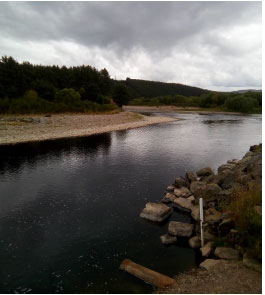
Image 4.5. River Spey
| Blue-Green Infrastructure |
|
|---|---|
| The Scottish Government is working together with Scottish Water, SEPA, Local Authorities and other stakeholders under the Blue-Green Cities Programme for Government commitment to develop approaches to drainage, which will reduce the burden on the sewerage. By retaining more water in rivers and soils, we can improve the environment, supporting biodiversity, while increasing leisure and activity potential. We will build on examples of work underway in Glasgow and elsewhere to establish new pilots of the Blue-Green cities approach. |
|
| Timeline: Ongoing |
Owners: Scottish Government |
| Hydro Nation: Scotland’s Centre of Expertise for Waters (CREW) |
|
|---|---|
| CREW[9] is a Scottish Government funded partnership between the James Hutton Institute and Scottish Universities, supported by the Marine Alliance for Science and Technology Scotland (MASTS). The centre provides a vital knowledge hub where calls for research are coordinated across academic institutions, government and the water sector, helping improve understanding of water in the environment, industry, pollution, resource management and technology. |
|
| Timeline: Ongoing |
Owners: Scottish Government |
| Hydro Nation: Scholars Programme |
|
|---|---|
| The Hydro Nation Scholars Programme[10] delivers high-quality PhD posts, directly funded by the Scottish Government, to study cutting-edge water topics. These posts are funded to help solve pressing challenges for the industry, create new expertise within Scotland, and develop the water leaders of the future, building Scotland’s international profile as a centre of water knowledge. |
|
| Timeline: Ongoing |
Owners: Scottish Government |
4.2.3 Transport
Transport in Scotland is a mixture of devolved and reserved competence. The road and bridge network has been devolved to the Scottish Government, as well as ScotRail, Scotland’s only rail franchise. Ensuring the resilience of these networks as the climate changes will be essential, as the Scottish Government adapts to the changing climate.
| Strategic Transport Projects Review 2 |
|
|---|---|
| Following the publication of the second National Transport Strategy, Transport Scotland will seek to publish the Second Strategic Transport Projects Review (STPR2). STPR2 will examine the strategic transport infrastructure interventions required to support Scotland’s Economic Strategy, including inclusive growth objectives, reflecting outcomes and priorities to be set out in the National Transport Strategy. The Strategic Transport Projects Review, published in December 2008, sets out the Scottish Government's 29 transport investment priorities over the period to 2032. |
|
| Timeline: Due for review following publication of the National Transport Strategy 2. |
Owners: Transport Scotland, Scottish Government |
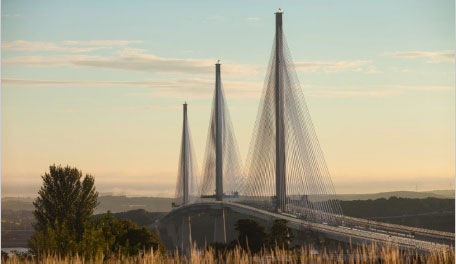
Image 4.6. Queensferry Crossing
Roads
Scotland’s roads are essential for connecting communities and delivering goods and services across the country. To continue to provide these connections, roads must be maintained so they remain accessible despite the potential damage and disruption caused by climate change.
Transport Scotland oversees the trunk road network in Scotland. The trunk road and motorway network is 3,507 km (2,179 miles) long, including slip roads and roundabouts. It has a gross asset value of over £20.8 billion and represents 6% of the total Scottish road network. It carries 35% of all traffic and 60% of heavy goods vehicles. Transport Scotland are working to enhance, manage and maintain a resilient transport network with reliable journey times and enhanced connections which promotes sustainable economic growth. Our management of trunk roads also includes ongoing maintenance work, looking after bridges and other structures, and putting landslide control measures in place.
| Scottish Road Network Landslides Study and Implementation Report |
|
|---|---|
| Climate change will impact on slope stability due to changes in soil moisture. Parts of Scotland may see a seasonal increase or decrease in the amount of rainfall experienced which can lead to an increase in the frequency of landslides. Adapting to landslides and flooding will form a key area of work for the Transport Sector. In 2005, Transport Scotland published the Scottish Road Network Landslides Study, following road closures after landslides the previous year. In 2009, we published an Implementation Report. This report identifies areas of current high hazard in Scotland and makes recommendations as to how to assess the Scottish road network and management approaches which could be adopted to mitigate the effects of landslides. |
|
| Timeline: Published in 2009. A review of recommendations started in 2018, with publication due in 2019. |
Owners: Transport Scotland, Scottish Government |
| Integrated Roads Information System and Disruption Risk Assessment Tool |
|
|---|---|
| Collecting and analysing data to determine areas of the transport network that are susceptible to flooding, inundation and subsidence is vital to improve our knowledge about the capability of assets to respond to climate change. The use of the Integrated Roads Information System tool to record incidents such as flooding will allow identification of vulnerable locations in the trunk road network and prioritise sites that require engineering interventions or continued monitoring. |
|
| Timeline: Ongoing |
Owners: Transport Scotland, Scottish Government |
| Scour Management Strategy and Flood Risk Emergency Plan |
|
|---|---|
| Bridge scour is the process where sediment from around bridge abutments or piers is removed by fast moving water. An increase in rainfall and flooding as a result of the changing climate could cause an increase in the frequency of scour, potentially causing structural damage. A Scour Management Strategy and Flood Risk Emergency Plan has been developed and implemented across Transport Scotland’s Operating Companies and Design-Build-Finance-Operate providers. The aim is to ensure a consistent approach to inspecting, monitoring, assessing and recording scour and erosion at structures and to improve interventions and mitigation measures. The strategy includes the monitoring of trunk road bridges and other structures, and enhanced monitoring of those structures which are known to be at risk. The strategy also includes installation of flood level marker plates next to high risk structures so that, during high rainfall events, inspectors can identify when flows approach or exceed critical flood assessment levels and recommend closure or restrictions of the structure until water levels recede and scour inspections can be undertaken. |
|
| Timeline: Implemented February 2018 |
Owners: Transport Scotland, Scottish Government |
| Landscape Management |
|
|---|---|
| Within the work of the Trunk Road divisions, the potential impact of climate change on our natural resources is managed via our Landscape Policy document, Fitting Landscapes. Through application of this mandatory policy, all works undertaken on the network must take account of the impact on the environment and local landscape character, whilst seeking opportunities to enhance the resource. The policy also requires designers and managers to consider the longer-term impacts of their works and build-in sustainability objectives. |
|
| Timeline: Ongoing |
Owners: Transport Scotland, Scottish Government |
| Preparing for Severe Weather Events |
|
|---|---|
| The UKCP18 projections note that there is likely be an increase in extreme weather events. Winter service operations allow safe use of the trunk road network and minimize disruption to users caused by snow or ice. Transport Scotland continues to develop and improve high wind management plans. All weather related incidents (including wind) are routinely reviewed to determine any necessary improvement actions. Our Met Office advisor based in the Traffic Scotland National Control Centre provides high wind forecasting for major bridges on the trunk road network to monitor, manage and disseminate information on restrictions and closures to operational partners, the public and the freight/haulage industry. |
|
| Timeline: Ongoing |
Owners: Transport Scotland, Scottish Government |
| Scottish Road Network: Climate Change Study and Implementation Plan |
|
|---|---|
| The Scottish Road Network: Climate Change Study (2005) and Implementation Plan (2008) gives direct recommendations to adapt the Scottish road network to cope with climate change. This study and implementation plan was updated following UK Climate Projections 2009 and consideration is being given to a further update following the UK Climate Projections 2018. |
|
| Timeline: Further detail will be available following publication of the National Transport Strategy 2. |
Owners: Transport Scotland, Scottish Government |
Rail
Rail infrastructure in Scotland is mainly reserved to the UK Government with the exception of the ScotRail franchise which is let by Scottish Ministers. The following policy supports the increased resilience of Scotland’s railways.
| Scottish Ministers’ High Level Output Specification, Control Period 6 |
|
|---|---|
| The most recent High Level Output Specification sets out how investment strategies must become more sustainable and ensure enhanced network resilience from adaptation interventions. Scottish Ministers also require Network Rail to work with the rail industry to develop and apply suitable Key Performance Indicators to monitor the impact and mitigation of climate change on network disruption and provide the means to measure the benefits of adaptation interventions. |
|
| Timeline: Ongoing |
Owners: Transport Scotland, Scottish Government |
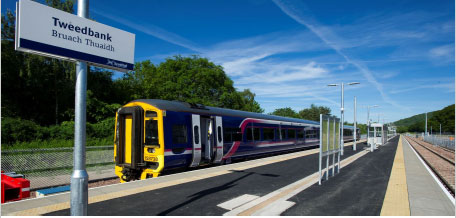
Image 4.7. ScotRail train at Tweedbank station
4.2.4 Health
Ensuring continued health service delivery despite possible climate-related disruption is essential. As Scotland’s climate changes, individuals can experience impacts on their health. Health infrastructure like hospitals, GP surgeries and treatment centres can also experience damage and disruption due to high winds, increased rainfall and flood events. Policies to support health resilience are included in Section 2.2.
| Climate Hazards and Vulnerabilities Risk Screening Tool for Healthcare Assets |
|---|
| A Climate Hazards and Vulnerabilities Risk Screening Tool for Healthcare Assets is being developed for NHS Scotland. The new screening tool will provide NHS Boards with a Scotland-wide resource that brings together natural hazard and health-related vulnerabilities to inform NHS Scotland risk assessment and planning processes. This includes identification of the risk of damage and loss to healthcare assets, sites and the infrastructure that supports them, for example, roads. More information can be found in Section 2.2.1.1. |
4.2.5 Emergency Services
Emergency services will likely become more important as the climate changes. Extreme weather events such as flooding and wildfires may become more frequent and emergency responders may have difficulty accessing certain areas to provide assistance. In Scotland, the police, ambulance, and fire and rescue service are all devolved to the Scottish Government. HM Coastguard is the only exception and is reserved to the UK Government.
| Scottish Wildfire Forum |
|
|---|---|
| Wildfires already cause substantial ecological and environmental damage and demand considerable and costly fire-management resources. They are expected to increase in magnitude and frequency due to the warmer and drier summers associated with climate change, and may also be exacerbated by land use change. The Scottish Wildfire Forum is committed to reducing the number and severity of wildfires in Scotland through collaborative working across all relevant sectors. The forum has developed a strategy, built upon prevention and communication, which complements the Scottish Government’s strategic objectives of “Safer and Stronger” and “Greener” and will strengthen the resilience of Scotland to the economic and social impact of wildfires. |
|
| Timeline: Ongoing |
Owners: Scottish Fire and Rescue Service |
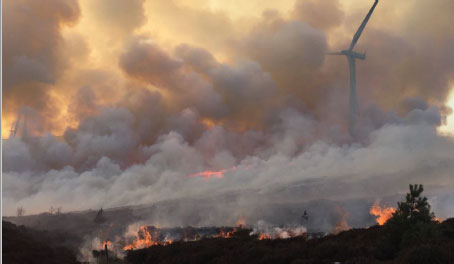
Image 4.8. Wildfire near Aberlour, Moray (© Scottish Fire and Rescue Service)
| Scottish Fire and Rescue Service Community Asset Register |
|
|---|---|
| During storms and heat waves, individuals, especially those who are elderly or more vulnerable, may become trapped in their homes and require rescue. In addition, key workers (emergency services, doctors, nurses etc.) may be trapped in their homes and unable to get to work. The Community Asset Register provides accurate information about the Voluntary Sector, organised groups’, business owners’ and individual’s skills, capabilities and equipment which could be made available to emergency responders to assist with emergency events. The Community Asset Register was developed by Scottish Fire and Rescue Service (SFRS) and launched across Scotland in October 2017. The register is also available to other agencies when responding to emergency events. The Scottish Government Resilience Division is currently drafting guidance, collaboratively with the Voluntary Sector and other Resilience Partners, to establish a ‘best practice’ model around how best to integrate the Voluntary Sector into wider Resilience Partnership structures and working arrangements and includes building on the Community Asset Register as a key resource. |
|
| Timeline: Ongoing |
Owners: Scottish Fire and Rescue Service |
4.2.6 Food
Climate change may cause changes to patterns of availability and distribution of different types of food for Scottish people. As agriculture is a cornerstone of Scotland’s economy, more detail on this can be found with provisioning ecosystem services, in Section 3.1.1.
4.2.7 Built Environment
Our built environment will need to adapt to our changing climate, and in particular, the likely projected increases in temperature (with greater warming in the summer than winter) and projected increases in rainfall in winter and reduced rainfall in summer. As the built environment is an integral part of community wellbeing, more detail can be found on this in Section 1.2.2 and Section 1.2.3.
4.2.8 Flooding
Climate change will likely increase the frequency of flood events across Scotland. It will be important to ensure that existing and new infrastructure is resilient to the impacts of flooding, as well as invest in specific flood risk management infrastructure, including blue-green infrastructure. As flooding impacts on people and the built environment, more detail on this can be found in Sub-Outcome 1.2.
Adaptation Behaviours
Adapting to climate change requires action from across all areas of society. The Scottish Government, local government, public bodies, the private sector, third sector, communities and individuals all have a role to play. While utility companies in Scotland have well-tested plans in place, individuals can also take simple steps to prepare for a short period without electricity, gas or mains water supplies. Individuals, communities and businesses can also take action to reduce pressure on our utilities and increase their resilience.
Individual Behaviours
1. A smooth running water cycle. Flushing wipes, nappies or cotton buds down the toilet can cause drains to block, resulting in flooding, people are encouraged to take care in what they flush.
2. Maintaining a well-stocked emergency kit at home can help if infrastructure networks are disrupted. Information on emergency kits is provided on the Ready Scotland website.
3. Individuals are encouraged to notify their energy supplier if they have a disability, are chronically sick, or depend on a continuous supply of power for medical equipment or mobility equipment, such as stair lifts and hoists. Energy suppliers work with local authorities so vulnerable people get the support they need during any disruptions to normal service.
Societal Behaviours
1. Businesses can prepare for severe weather by ensuring that they have appropriate insurance cover for all aspects of their business and talk to their staff about what 'essential travel' means for them and their business.
2. Businesses are also encouraged to put contingency plans in place for power, phone or other utility failure and plan how they would operate if they could not access or use part of their premises, and how they would evacuate staff or move stock.
Monitoring and Evaluation: Outcome 4
Monitoring and Evaluation is integral to the outcomes-based approach which encourages consideration at all stages of adaptation policy development. Further information including a general introduction to the framework, and a description of the foundation and principles can be found in the monitoring and evaluation introduction and Annex 3 respectively.
Key sources of existing monitoring evidence for Outcome 4 include: the National Flood Risk Assessment, Scottish Water, National Transport Statistics, and the Scottish Fire and Rescue Service. There is currently limited data available for some themes, but by identifying what we need to measure not just what we know we can, the framework highlights monitoring gaps which will be filled as more data and associated monitoring arrangements are developed.
Monitoring the Adaptation Process (‘What are we doing?’) The themes set out the structure to monitor the implementation of and output from adaptation policies and actions which support the Outcome. Indicators will include metrics of, for example: coverage of condition assessments and resilience plans, staff training, and the use of place-based approaches.
Monitoring the Sub-Outcomes (‘Is it working?’) The Sub-Outcome monitoring themes highlight the key components of each Sub-Outcome and provide the structure for evaluating progress. Indicators will include metrics of, for example: exposure risk of key infrastructure, disruption to services, and satisfaction level of service users.
Monitoring the Outcome Monitoring at this high level will directly link the Outcome to wider government policy and the National Performance Framework by utilising relevant indicators already associated with these high-level monitoring frameworks.
| National Performance Framework Indicators |
Sustainable Development Goals Indicators |
|---|---|
|
|
Monitoring and Evaluation Structure: Outcome 4
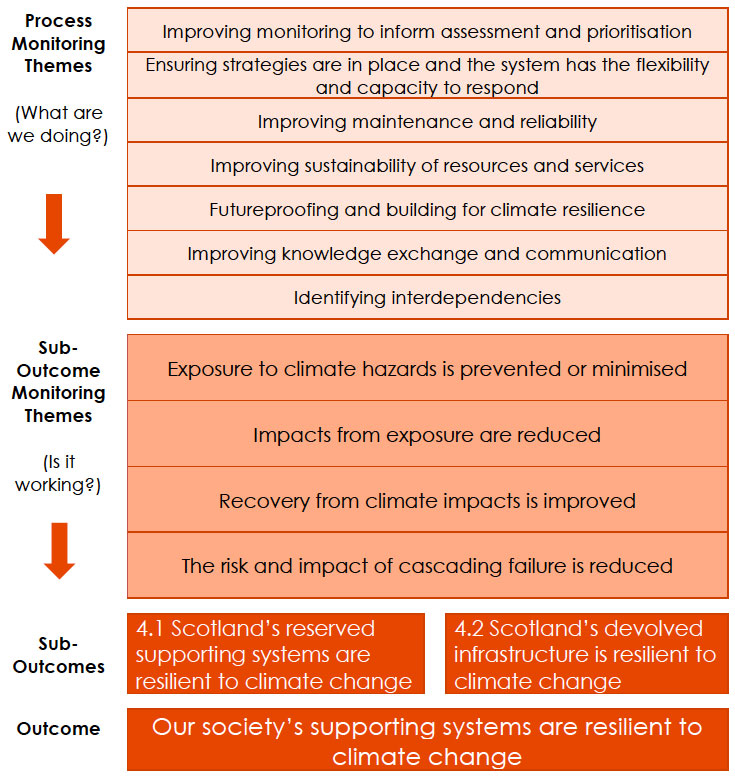
UK Climate Change Risk Assessment: Associated Risks
The UK Climate Change Risk Assessment risks that will be addressed by the policies presented in Outcome 4 are set out below:
| In1: |
In2: |
In3: |
| In4: |
In5: |
In6: |
| In7: |
In8: |
In9: |
| In10: |
In11: |
In12: |
| In13: |
In14: |
PB2: |
| PB13: |
PB14: |
Contact
Email: roddy.maclean@gov.scot
There is a problem
Thanks for your feedback